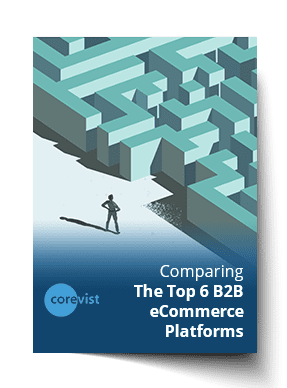Share
Author
George Anderson
Share
First published Nov 14, 2018. Updated Aug 11, 2021.
If you’re an industrial manufacturer, you have a clear-cut line of products. But one of your most important products doesn’t have an SKU defined in SAP. It’s your customer experience.
Your customer experience can differentiate you from the competition, either for good or ill. Since B2B eCommerce transforms your customer experience, it’s a new product. It needs a product owner, a B2B eCommerce Lead, who can take it from concept to profitable execution.
Let’s talk about B2B eCommerce as a product and what that product owner (the B2B eCommerce Lead) should look like.
Why companies must define the role of B2B eCommerce Lead
If you’re not convinced B2B eCommerce is a product in need of a product owner, consider these two questions. They’re the two biggest challenges which B2B organizations encounter when they want to launch eCommerce:
- Who owns the digital transformation within our business?
- What are the real drivers, goals, and performance metrics of our digital transformation?
Now imagine those questions recast in terms of product:
- Who owns the product within our business?
- What are the real drivers, goals, and performance metrics for this product launch?
The questions are the same. And just as you would name a product owner for the launch of a groundbreaking new product, you need to do the same with eCommerce.
Where the B2B eCommerce Lead fits into the organization
You might be scratching your head at this point, thinking, “This sounds like a great idea, but who is this B2B eCommerce Lead? Are they in my department? The one next door?”
Let’s go back to those questions for a moment.
- Who owns the digital transformation within our business?
- What are the real drivers, goals, and performance metrics of our digital transformation?
Here’s the thing. However you frame those questions, they transcend any one department.
Like any other product you launch, B2B eCommerce transcends departmental silos like Sales, Marketing, and Customer Service. In fact, digital transformation–the launching of this new product called eCommerce–is nothing less than organizational transformation. That’s why it’s imperative to define the new role of eCommerce Lead.
Here’s the hard part for industrial manufacturers. The eCommerce Lead doesn’t really fit into any existing departments or silos at the organization. It’s not strictly an IT function, and it’s not strictly Marketing or Operations, either. Companies generally assign this role under one of those umbrellas, but that’s a risky move.
Why? Because each of those silos is… a silo. When you launch a new product for your customers, IT isn’t the owner. Neither is Marketing or Sales. They’re all collaborating on a larger goal (even if they don’t realize it)–making this new product a success in the market.
Customer experience as a product is different. Up till now, it hasn’t really required a leader who owns it. But the digital landscape pushes all customer interaction into a technology platform. It’s this shift that necessitates the role of the eCommerce Lead.
In a best-case scenario, the eCommerce Lead reports to the CEO—or at the very least, doesn’t report within one of those traditional silos. This role requires the ability to knit together disparate parts of the business like Sales, Marketing, IT, and Operations. That’s only possible if the eCommerce Lead sits outside the silos that he/she knits together.
What the B2B eCommerce Lead does
Now that we’ve explained the need for this new role (and why it doesn’t fit into existing silos), we’re ready to look at what the eCommerce Lead actually does. It’s a long list of responsibilities, precisely because eCommerce as a customer experience product has the power to impact every part of the business for good or ill. We won’t look at every responsibility in detail, but we’ll sort them into these primary areas.
1. The B2B eCommerce Lead advocates for the customer to all internal stakeholders
It’s easy to look to internal perspectives and processes for guidance in eCommerce, especially if you don’t see it as a product. But think how disastrous that would be in a traditional product launch. Teams like Operations and IT aren’t equipped to understand the market needs which your product will (or won’t) fill. They’re strictly focused on administration.
And while CSRs, Sales reps, Marketing, and IT all have important viewpoints which you can’t ignore, none of them is a direct proxy for the customer, and they most likely aren’t thinking of eCommerce as a product. That makes it dangerous to rely on their perspectives alone.
Here’s where the eCommerce Lead must step up: they have to be the #1 customer advocate within the organization, scouting market needs in customer experience and designing a product (your eCommerce presence) that meets those needs. Stakeholders from existing silos can’t provide that holistic, total vision of eCommerce as a product.
When you focus on your customer’s experience (and therefore your customer), a funny thing happens. Most companies see gains in customer loyalty, NPS, and account value. The customer should come first in your business, and appointing an eCommerce Lead allows you to reorient around that goal from the perspective of eCommerce.
2. The B2B eCommerce Lead evaluates platform options
Who else is going to compare B2B eCommerce platforms? The B2B eCommerce Lead must understand the needs and concerns of all stakeholders impacted by B2B eCommerce. They need to take that knowledge and use it to find the ideal platform for the organization—not just for customers (or for the loudest internal voices), but for everyone.
FREE Chart
Compare Top 6 B2B Platforms
Find your best fit based on revenue size, complexity, and depth of SAP integration required. Compare SAP Commerce Cloud, Salesforce B2B Commerce, and more.
3. The B2B eCommerce Lead advocates for an architecture that creates LESS work for IT
Unfortunately, most B2B eCommerce solutions require convoluted architecture to integrate to the ERP. If the organization has numerous IT resources who can maintain the integration full-time, then the B2B eCommerce Lead doesn’t have to be picky about architecture—they can recommend a conventional platform that doesn’t include ERP integration.
However, if the organization’s IT team already has enough on their plates, the B2B eCommerce Lead must think carefully about ERP integration. In these scenarios, a solution that includes ERP integration is a great option. That’s the thinking behind the Corevist Platform.
4. The B2B eCommerce Lead defines the MVP (and fights for it)
With so many options in B2B eCommerce (and so many voices with opinions), it’s easy for organizations to lose their way as they’re crafting a B2B eCommerce program. That’s why it’s essential for the B2B eCommerce Lead to define the MVP (minimally viable product)—the essential form that B2B eCommerce must take at the organization. The B2B eCommerce Lead is the one to define this because they’ve listened to all stakeholders, evaluated platforms, and considered their ERP integration options.
5. The B2B eCommerce Lead provides the overall roadmap (and knows when to revise it)
The most successful businesses don’t see eCommerce as a point-in-time solution, but as a product on a journey. That perspective means you need a roadmap to apply the customer-first vision. It also means knowing when to revise the roadmap as the market’s preferences for eCommerce as a product evolve. That way, you keep eCommerce aligned to new corporate strategies, identify risks and opportunities, and maximize ROI.
In other words, the eCommerce roadmap must be a living, breathing entity that’s constantly revised with new data.
Only a dedicated leader can provide that. IT has many other problems to worry about; Marketing is not primarily tasked with the satisfaction of eCommerce users. That’s why roadmap creation, monitoring, and revision must fall to the eCommerce Lead.
6. This role leads organizational change (and manages the culture shift that goes with it)
Because the eCommerce Lead often doesn’t exist yet, all other executive stakeholders tend to overlook the impact of organizational change and culture shift. (Hence the need for the role!) There’s simply no way around it—eCommerce will change your company forever, both in processes and in culture.
Change without leadership is chaos. That’s why organizational and cultural change are the responsibility of the eCommerce Lead. This person must develop a thoughtful plan to manage that change internally. That means engaging evangelists within the organization, developing communications plans, and training internal and external users. These things simply won’t happen on their own. They need a leader who will own them.
What does that look like in day-to-day operations? It means facilitating a smooth transition to eCommerce in all parts of the organization. Here are a few examples–there are many more:
- Ensuring eCommerce really does eliminate manual work, rather than shifting it to another department.
- Ensuring Sales is on board with eCommerce from the start so their commissions (and their opinions of eCommerce) aren’t negatively impacted.
- Ensuring Marketing knows what you expect of them in terms of driving eCommerce adoption.
- Ensuring the warehouse understands their new fulfillment requirements.
- Transitioning Finance to accept credit cards.
FREE Chart
Compare Top 6 B2B Platforms
Find your best fit based on revenue size, complexity, and depth of SAP integration required. Compare SAP Commerce Cloud, Salesforce B2B Commerce, and more.










